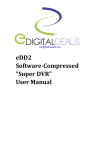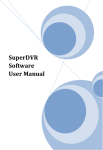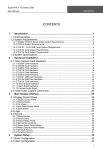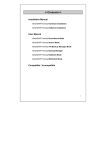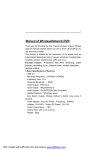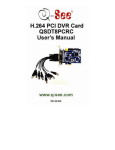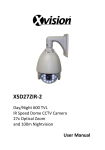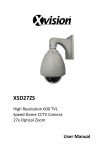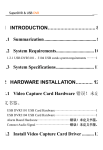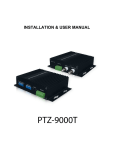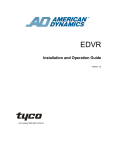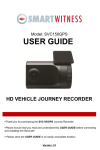Download User Manual
Transcript
CCTV Model: XUSB4DVR 4 Camera 25fps USB DVR Card and Software Before you begin • Please unpack all boxes carefully and identify that all the parts are present. • Do not cut the cables, this will void the warranty. Model: XUSB4DVR 4 Camera 25fps USB DVR Card and Software User Guide 2 XUSB4DVR User Guide CONTENTS 1 INTRODUCTION ............................................................................................5 1.1 OVERVIEW ................................................................................................... 5 1.2 FEATURES...................................................................................................... 5 1.3 SYSTEM REQUIREMENTS ............................................................................. 6 1.4 SYSTEM SPECIFICATIONS ............................................................................ 6 2 HARDWARE INSTALLATION........................................................................ 8 2.1 VIDEO CAPTURE CARD HARDWARE............................................................. 8 2.1.1 XUSB4DVR Card Hardware.............................................................. 8 2.2 INSTALL VIDEO CAPTURE CARD DRIVER...................................................... 8 3 MAIN DISPLAY INTERFACE ....................................................................... 11 3.1 LOGIN........................................................................................................... 11 3.2 DISPLAY CONTROL PANEL ........................................................................... 11 3.2.1 Flip Pages ........................................................................................ 12 3.2.2 Auto Dwell display Mode................................................................. 12 3.2.3 Quick Switch ................................................................................... 12 3.3 RECORD ....................................................................................................... 12 3.3.1 Record Modes ................................................................................. 12 3.3.2 Recording Multiple Cameras............................................................ 12 3.3.3 Record Setup .................................................................................. 13 3.3.4 Record Status Panel ........................................................................ 14 3.3.5 Manual Record Mode ..................................................................... 14 3.3.6 Schedule Record Mode ................................................................... 14 3.3.7 Motion Detection Record Mode ...................................................... 14 3.3.8 Sensor Alarm Record Mode ............................................................ 15 3.3.9 Recycling Record ............................................................................. 15 4 SYSTEM SETUP .............................................................................................16 4.1 BASIC CONFIGURATION .............................................................................. 16 4.2 SCHEDULE CONFIGURATION........................................................................ 17 4.3 VIDEO CONFIGURATION .............................................................................. 17 4.4 MOTION DETECTION CONFIGURATION ....................................................... 18 4.4.1 Set Motion Detection Area............................................................... 18 4.4.2 Set Motion Detection Sensitivity ..................................................... 18 4.5 ALARM CONFIGURATION ............................................................................ 18 4.5.1 Alarm Triggering Conditions Configuration...................................... 18 4.5.2 Alarm Record .................................................................................. 19 4.5.3 Alarm Output Tab ............................................................................ 19 4.5.4 Auto Mail Function Tab.................................................................... 20 4.5.5 Emap Tab.......................................................................................... 20 4.6 PTZ CONTROL CONFIGURATION ................................................................. 20 3 XUSB4DVR User Guide 4.6.1 Protocol Setup ................................................................................ 20 4.6.2 Serial ports setup ............................................................................ 21 4.7 USERS CONFIGURATION .............................................................................. 21 4.7.1 Add User ........................................................................................ 21 4.7.2 Change User rights ......................................................................... 21 4.7.3 Delete User ..................................................................................... 22 4.8 E-MAP CONFIGURATION.............................................................................. 22 4.8.1 Edit a map ...................................................................................... 22 4.8.2 View the map.................................................................................... 23 5 P.T.Z CONTROL ............................................................................................ 24 6 RECORD SEARCH AND PLAYBACK ........................................................... 26 6.1 RECORD SEARCH ......................................................................................... 26 6.2 RECORD PLAYBACK AND CONTROL ............................................................ 26 6.3 OTHER FUNCTIONS ...................................................................................... 28 6.3.1 Record File Backup .......................................................................... 28 6.3.2 Delete Recorded Files ...................................................................... 28 6.3.3 Capture Pictures .............................................................................. 28 6.3.4 Image Zoom In / Out ....................................................................... 30 7 REMOTE SURVEILLANCE AND PLAYBACK .............................................. 31 7.1 REMOTE LIVE SURVEILLANCE ...................................................................... 31 7.1.1 Remote Surveillance Server Configuration ...................................... 31 7.1.2 Remote Surveillance Client-side Setup ........................................... 31 7.2 REMOTE PLAYBACK ..................................................................................... 34 7.2.1 Remote Playback Server Configuration ........................................... 34 7.2.2 Remote Playback Client-side Setup.................................................. 34 7.2.3 Remote Playback Configuration and Control Setup......................... 35 7.3 MOBILE SURVEILLANCE................................................................................ 37 7.3.1 Introduction to Mobile Surveillance ................................................ 37 7.3.2 Client Configuration of Windows Mobiles ...................................... 37 7.3.3 Client Configuration of Symbian 60 ............................................... 38 APPENDIX 1: FREQUENTLY ASKED QUESTIONS ....................................... 40 APPENDIX 1.1 ABOUT INSTALLATION ............................................................... 40 App 1.1.1 Cannot Install the SmartDVR Driver ....................................... 40 App 1.1.2 Why can’t I run SmartDVR in the Windows 2003 OS? .......... 40 App 1.1.3 ‘Unspecified error’ in the End of Installation .......................... 40 App 1.1.4 Cannot find XUSB4DVR in Device Manager ........................... 40 APPENDIX 1.2 HOW TO USE SMARTDVR............................................................ 41 App 1.2.1 What are the meanings of the indicator lights ....................... 41 App 1.2.2 How do the different record modes work? ............................ 41 App 1.2.3 How do I set Recycling Record mode on the system? ........... 41 4 XUSB4DVR User Guide App 1.2.4 How to set the Auto Reboot function? .................................. 41 App 1.2.5 How to quickly use the Schedule Record function? ............... 41 App 1.2.6 What are the byte rates for different image qualities? .......... 41 App 1.2.7 The frame rate seems to be lower than what I set? .............. 42 App 1.2.8 Why I can’t select more channels to backup? ........................ 42 App 1.2.9 When should I select manual Gain Control? .......................... 42 APPENDIX 1.3 HOW TO USE THE NETWORK FUNCTION.................................... 42 App 1.3.1 How do I monitor on the client-side? .................................... 42 App 1.3.2 Why I can’t download the client-side software?.................... 42 App 1.3.3 Why can’t the server be configured at the clientside? .......... 42 App 1.3.4 Why I can’t see the images?.................................................. 42 App 1.3.5 What should I do if the Internet speed is quite slow? .......... 43 App 1.3.6 Why I can’t start WebCam server or RPB server? .................... 43 APPENDIX 1.4 OTHER QUESTIONS .................................................................... 43 App 1.4.1 Why doesn’t the computer display work, and why can’t I access the window system? .................................................................... 43 App 1.4.2 Why I can’t find the recorded files? ........................................ 43 App 1.4.3 Why is the screen’s display is unstable with dithering and water-wave images? ............................................................................... 43 App 1.4.4 Why is there a delay to playback, and why is it slow to close and open the driver? ...................................................................... 44 App 1.4.5 Why can’t I playback?............................................................. 44 App 1.4.6 Why do I see some grey blocks on time progress bar area when I playback? .................................................................................... 44 App 1.4.7 Why do I see some old record sections that can’t be covered when I playback? ..................................................................................... 44 App 1.4.8 Precautions on changing system time .................................... 44 App 1.4.9 If the system time must be changed, make the following preparations first: .................................................................................... 45 APPENDIX 1.5 SYSTEM QUESTIONS .................................................................. 45 App 1.5.1 How to use REPAIRDB to repair SmartDVR database? .......... 45 App 1.5.2 How to setup power options in the Microsoft VISTA system... 45 APPENDIX 2: QUICK START .......................................................................... APPENDIX 2.1 TROUBLESHOOTING .................................................................. App 2.1.1 When I open the SmartDVR application, it says ‘Can’t find Card ......................................................................................................... App 2.1.2 How do I setup the Web Client to monitor from the Internet? .................................................................................................. 46 46 46 47 APPENDIX 3 FUNCTION TREES...................................................................... 48 APPENDIX 4 NOTES ...................................................................................... 51 5 XUSB4DVR User Guide 1 INTRODUCTION 1.1 OVERVIEW Thank you for choosing this Xvision USB Card and Software. The USB Card adopts MPEG4 compression format, and allows up to 4 cameras to be recorded in real-time for live surveillance and playback, all from a PC/laptop. The cameras can also be viewed and played back a remote PC on the same LAN or on the Internet. In addition to this it can also synchronise the recording and transmission of audio from up to 2 cameras. This user guide will show you how to install the hardware and the SmartDVR 5.0 Software, and how to setup the systems of this range of products. To maintain the stability of your PC DVR system, please make sure you operate the product in accordance with this user guide. 1.2 FEATURES The following are standard functions of the XUSB4DVR: 1. Schedule record mode You can choose any period in a day to record and set up the record modes, i.e. sensor alarm record, motion detection record, manual record, schedule record. 2. Motion detection mode Motion detection areas are adjustable and you can assign up to 16 areas for detection for each channel. You can also set the motion detection sensitivity for each channel. The system will only begin to record only when motion in the detection area occurs, and it will stop recording after a period of time which also is adjustable. 3. Recycling record mode You can set the recording Storage Sequence for HDD partitions. The recording storage will automatically jump to the next partition when it is full. If all the partitions are full and recycling record mode is enabled, the old recorded data will be recycled and recorded over with new data. You can also set a HDD Minimum Storage Alarm. Once the present storage space is less then the minimum storage and recycling record mode is not enabled, the recording will automatically stop. This means old data will never be recorded over. 4. P.T.Z control function Supported by a number of decoders, you can control multiple speed domes and integrated cameras. Controls include Pan, Tilt, Zoom, Focus and Iris Adjustment for P.T.Z devices. The system also supports Preset Points and Auto Seek. 5. Management of Users Different users can have different rights, user names and passwords, so as to ensure system is secured against unauthorised users. 6. Multi-channel display Supports Multi-channel Display mode, Full Screen display and Auto Dwell display. 6 XUSB4DVR User Guide 7. Real Time Recording The USB Card can support up to 4 channels with a maximum frame rate of 25 fps. 8. Image Quality Features MPEG4 compression, which greatly reduces HDD usage and supports 352x288 and 704x576 (PAL) standard resolutions. Also allows you to adjust the image colour for each channel, including contrast, lightness, hue and saturation. 10. Powerful video playback functions Including playback, pause, stop, fast-forward, single-frame play and image capture. 11. Support advanced search mode Users can search by date/time, camera, record mode, or a combination of the three methods. 12. File Management Supports recorded files backup, delete by date/time, camera. 13. Multiple Language support Including Chinese (Traditional), English, German, Spanish, Portuguese and other customised languages. 14. Remote Surveillance You can view, playback and have PTZ Control from a remote PC on the same LAN or Internet 15. Alerts Set buzzer and Email alerts with image snapshots when motion is detected 16. User-friendly graphical user interface Simple user interface allows you to control the system with ease 17. Decrease file fragmentation Features NTFS partition to decrease fragmented files 1.3 SYSTEM REQUIREMENTS The following are the minimum system requirements for your PC: Operating System: Windows XP or Vista CPU: Pentium 4, 1.7GHz or above Graphics: Nvidia Geforce 2/ATI Rage 128 compatible or similar RAM: 256MB Direct X: Version 9 or above USB 2.0 Sockets required: 1 Please Note: When the recording disk partition’s format is FAT32 and the system has run for a long time, the system will create a lot of data fragments, that may result in the system running slowly. We recommend that you defragment your hard disk every 10 to 30 days. We strongly suggest that recording disk partition uses NTFS format. 7 XUSB4DVR User Guide 1.4 SYSTEM SPECIFICATIONS Format: PAL/NTSC Resolution: 352x288 / 704x576 (PAL) Maximum Frame rate: 25 fps (PAL) Screen set: Resolution 1024x768, 16 bits or 32 bits Compression code rate: 50kbps – 1.2Mbps Data format: MPEG4 8 XUSB4DVR User Guide 2 HARDWARE INSTALLATION 2.1 VIDEO CAPTURE CARD HARDWARE 2.1.1 XUSB4DVR Card Hardware Audio Input (White) Video Input (Yellow) USB Connection Fig 2.1 XUSB4DVR USB Video Capture Card Please Note: • Make sure that your PC USB interface is 2.0; the XUSB4DVR card can only support USB 2.0. • Please follow the steps to safely remove the USB card: Right click on the Taskbar > Stop device > pull out the USB card. • Using this card with other USB device simultaneously may cause mean that PC is unable to identify the USB card. • Do not insert two or more USB video capture cards simultaneously. • Do not use with any other PCI video capture card simultaneously. 2.2 INSTALL VIDEO CAPTURE CARD DRIVER Connect the USB plug on the XUSB4DVR to a spare USB port on your laptop/PC and insert the Software CD into the CD drive. Run ‘Setup.exe’ (located in ‘Install’ Folder), and the installation interface will appear. Select ‘Next to continue. Fig 2.2 Welcome Page 9 XUSB4DVR User Guide Select Video format and then click ‘Next’ to continue. For UK video format, select PAL Fig 2.3 Select video format After this process, the application package SmartDVR will begin installation. Select a suitable destination option, and click ‘Next’. Fig 2.4 Select installation destination Click ‘Next’ to continue. Fig 2.5 Select Program Folder 10 XUSB4DVR User Guide The Software will finish installing. Click ‘Finish’. Now, restart the computer and start the surveillance program. Fig 2.6 Driver and application installation finished You will see a shortcut will have been created on the desktop: Fig 2.6.1 Shortcut of SmartDVR Please Note: When you install the driver software on a Microsoft VISTA system, you need select the option shown below when you start the installation process. After this, follow the same steps as outlined previously for installing the software on a Microsoft XP system. If you cannot run the SmartDVR program, users should restart the computer. Fig 2.7 Install the Software on a VISTA system 11 XUSB4DVR User Guide 3 MAIN DISPLAY INTERFACE When you run the SmartDVR program the Main Display interface will appear. The display will be locked until you Login. TIME & DATE MAIN DISPLAY CAMERA STATUS ALARM OUT STATUS LOGIN E-MAP SEARCH & PLAYBACK CONFIGURATION EXIT BUTTON DISPLAY MODE CONTROL PANEL DISK SPACE INDICATOR PTZ CONTROL Fig 3.1 SmartDVR Main Display Interface 3.1 LOGIN Click , and the Login window will appear. Input the user name and password. (The default user name is ‘SYSTEM’ with no password). When you have logged in you will have access to the main interface. You can change the system password and create new user names and passwords once you enter the system. (Refer to Chapter 4.7 Users Configuration). 3.2 DISPLAY CONTROL PANEL The Display Control Panel includes ‘Display Mode’ buttons, a Free Disk Space indicator, ‘Next Page’ button, ‘Auto Dwell’ button, 1 channel and 4 channel display buttons. Every button has its built-in indicator light which will light on and off to indicate its working status. Read below for the functions in the Display Control Panel. 12 XUSB4DVR User Guide Fig 3.1 SmartDVR Main Display Interface NEXT PAGE AUTO 1CH DWELL 4CH DISK SPACE INDICATOR 3.2.1 Next Page When in 1CH or 4CH display mode click the NEXT PAGE button to quickly switch to the next channel in the display according to the mode. 3.2.2 Auto Dwell See all the channels in sequence with the Auto Dwell display mode. 3.2.3 Quick Switch If you are in 4CH display mode, by clicking any image, the display will quickly switch to the corresponding single channel display mode. By clicking the single image again, it will return to the former display mode. 3.3 RECORD 3.3.1 Record Modes The XDVR4USB offers 4 kinds of record modes: 1. Schedule record mode (timer) 2. Manual record mode 3. Motion Detection record mode 4. Sensor Alarm record mode Using Motion Detection record mode and Sensor Alarm record mode together is called Alarm Record mode. 3.3.2 Recording Multiple cameras When you record multiple cameras, every camera works separately and the recorded file are also saved separately. The parameters, i.e. Camera ID, the Date and Time and the Record Mode used are all saved together with the record file. 13 XUSB4DVR User Guide 3.3.3 Record Setup Click on the CONFIGURATION button to enter the System Setup page, then on the BASIC CONFIGURATION button and go to the ‘Record Panel’. It is in this section that you can set up all kinds of necessary parameters for recording (see Chapter 4- System Setup). Fig 3.5 Record Configuration Panel • Time stamp Select this option if you want the date / time of recording to appear on the recorded images. • Switch By selecting this options, you can turn on corresponding cameras. If there is no camera connected to certain channels, don’t select the option to save unnecessary recording. • Manual record For continuously recording and saving the corresponding camera channel(s). • Manual recording frame rate Select the recording frame rate required for Manual Record mode. • Schedule Record For Schedule recording day or night of corresponding cameras. The times of recording can be set within the Configuration page. • Schedule Record Frame Rate Select the recording frame rate required for Schedule Record mode. • Motion Detection For recording the corresponding camera(s) when motion is detected. • Motion Record Frame Rate Select the recording frame rate required for Motion Detection Record mode. • Sensor Record Frame Rate If sensors utilized to trigger recording, users can select record frame rate here. • Camera Security Users are divided into three standards: Normal user, Power user and Administrator. By selecting this option, only administrators can see the corresponding camera channels. • Record Quality Select the image recording quality here. • Audio In The XUSB4DVR can support two channels of audio. You can choose up to two camera channels to enable the audio recording from these corresponding camera(s). Please Note: You can select more than one record mode. 14 XUSB4DVR User Guide 3.3.4 Record Status Panel The meanings of the indicator lights in the Record Status Panel are: Normal State (no light, greyed out) Manual Record mode (lime green light) Schedule Record mode (bottle green light) Motion Detection mode State (yellow light) Sensor Alarm Record mode (red light) Video Loss State (blue light) Fig 3.6 Record Status Panel and Alarm Output Status Panel The status panel is split in two sections. The top indicator lights refer to the status of the CAMERAS connected to the system.The second section refers to ALARM outputs. ie. when an indicator light turns red in the second row, it means there is alarm output. 3.3.5 Manual Record Mode Manual Record mode is the most commonly used record mode. If any special event happens, users can select this mode and record continuously. In this mode, the indicator light in the Record Status Panel will turn lime green. Please Note: You can select a high frame rate for short periods of Manual recording, and select a low frame rate for long periods of Schedule Record. 3.3.6 Schedule Record mode Users can set a working schedule for all kinds of record modes in ‘Schedule Configuration’. The bottle green light in the Record Status Panel will show the corresponding channel is in Schedule Record mode. You can change the record mode to Manual Record at any time, and the bottle green light will change to lime green. Please refer to chapter 4.2 for details. 3.3.7 Motion Detection Record Mode This mode will enable the system to detect image changes and begin to record automatically by activating the Motion Alarm Record mode. For instance, if somebody opens the door, the system will detect changes in the image and begin to record. Later, you can play back the recorded file and find out who opened door. When there is no movement, the system will not record and that is helpful for saving system resources like hard drive space, and convenient for searching for legitimate event files. When motion is detected, the indicator light in the Record Status Panel will turn yellow. Please Note: Users need to setup up to three things to enable Motion Detection Recording: 1. Select ‘Motion Detection’ for certain channels in ‘Basic Configuration’. 2. Configure the motion detection areas for certain channels in ‘Motion Detection Configuration’. Refer to chapter 4.3 for details. 3. Configure the working schedule for certain channels in ‘Schedule Configuration’. Refer to chapter 4.4 for details. 15 XUSB4DVR User Guide 3.3.7 Sensor Alarm Record Mode Users can use sensors to trigger Sensor Alarm Record mode for corresponding channels. In this mode, the Record Status indicator light in the ALARM section will turn red. 3.3.8 Recycling Record You can enable the Recycling Record function and set the recording storage sequence for HDD partitions. The recording storage will automatically jump to the next partition when it is full. If all the partitions are full and Recycling Record mode has been enabled, the new data will overwrite the oldest recorded data automatically. Please refer to chapter 4.1 for details. You can also set the HDD Minimum Storage alarm. When the current storage space is less then the minimum storage level set and Recycling Record mode has not been enabled, record will automatically stop. Please refer to chapter 4.5 for details. 16 XUSB4DVR User Guide 4 SYSTEM SETUP Click on the CONFIGURATION button to enter the main System Setup page. The buttons shown at the bottom of the screen are: Basic Configuration Schedule Configuration Video Configuration Motion Detection Configuration Alarm Configuration P.T.Z Configuration User Configuration Return Fig 4.1 Basic Configuration 4.1 BASIC CONFIGURATION Click to enter the Basic Configuration page where you can setup the system or just use the defaults. NOTE: You can Click to return to the main display interface at any time. Below are the options available in the Basic Configuration screen: Dwell Interval Set the dwell time between images for Auto Dwell display mode. Select from dropdown. Caption There are four options to select for all the channels. Select from dropdown. • ‘None’ means no title; • ‘ID’ means camera numbers, i.e. 1, 2, 3, 4 • ‘Name’ means camera names, i.e. Cam1, Cam2 etc Fig 4.2 Basic Configuration • ‘ID/Name’ means both camera number and camera name, i.e. 1/Cam1, 2/Cam2 etc Resolution There are two options, 352x288 and 704x576 for you to set the resolution for all the channels. The video may have interlace lines if the you select 704x576, so you can select the option to solve this problem. Note:De-Interlacing will use much more of the PC’s processing speed. Storage Disk The XUSB4DVR system shows all the available HDD partitions. You can select one or more of the partitions that will be used in sequence from top to bottom. Check the Recycle option to allow the 17 XUSB4DVR User Guide the system to automatically overwrite over old data if you have not set up the HDD Minimum Storage alarm in the Motion Detection Configuration menu. Please refer to chapter 4.5 for details. Internet Config Tab Read more about this tab in chapter 7 Remote Surveillance and Playback. PC Auto Reboot Tab The windows system may become unstable after a couple of days continuous operation. You should reboot the PC/laptop regularly to avoid the SmartDVR system from becoming unstable. In the following area of the Basic Fig 4.3 PC Auto Reboot tab Configuration page, you can input your computer’s user name and password in the relative boxes. You can select and set the interval by day, which will guide the system to reboot automatically according to the setup. When restarting the PC/laptop, the SmartDVR system will access the system automatically with details you enter. 4.2 SCHEDULE CONFIGURATION Click to enter the Schedule Configuration page. The XUSB4DVR SmartDVR system offers powerful schedule configuration options. Every channel has three kinds of record modes: Schedule Record, Motion Detection Record and Sensor Alarm Record. You can set schedules from Sunday to Saturday separately for all of the three record modes. Sensor alarm record mode has the highest priority Fig 4.4 Schedule Configuration & Edit Schedule detail among all record modes. To edit the schedule for a channel, select the camera name within one of the three record mode groups, select the colour bars on the right side, then select ‘Edit’. Alternatively you can click ‘Add’ to add schedule for a certain channel (as shown in Fig 4.5). Click ‘Delete’ to delete schedule. Click ‘Clear All’ to delete all the schedules of a certain channel. 4.3 VIDEO CONFIGURATION Click to enter the video configuration page. Users can change the values of corresponding settings for each camera by selecting it from the drop down menu. You can adjust the Contrast, Brightness, Hue and Saturation by moving the scroll bars. To return to the default settings, click ‘Defaults’. Fig 4.5 Video Configuration 18 XUSB4DVR User Guide 4.4 MOTION DETECTION CONFIGURATION Click page. to enter Motion Detection Configuration Definition of the setup items: Sensitivity Set motion detection sensitivity here. Select all Selects all of the area of the channel as the detection area Clear Clears all the detection areas so you can customise the detection area. Fig 4.6 Motion Detection Configuration 4.4.1 Set Motion Detection Area If you want to customise a detection area for a certain channel, first select the camera from the dropdown menu, then select ‘Clear’. Then drag the cursor on the camera image over the area you want set to have motion detection. You can select a maximum of 16 areas for each channel. The set area(s) will be bounded by a green box. Click ‘Clear’, to clear all the selected areas of motion detection. 4.4.2 Set Motion Detection Sensitivity Within the green-boxed areas, set the value for Motion Detection Sensitivity. The higher the number the higher the sensitivity of detection. 4.5 ALARM CONFIGURATION Click to enter Alarm Configuration page. 4.5.1 Alarm Triggering Conditions Configuration The system can receive alarm both from local device and network 1. LOCAL ALARM RECORD TRIGGERING CONDITIONS CONFIGURATION • Buzzer Fig 4.7 Local place alarm triggering conditions Users can select whether to turn on the computer buzzer if an alarm gets triggered. Select value (seconds) from the dropdown menu. • Full Screen Alarm When an alarm is triggered (ie. when motion is detected), the corresponding camera channel can be set to appear full screen to alert you. Select value (seconds) from the dropdown menu. • Disk Shortage Alarm If the HDD space available is less then the set value, the buzzer will beep if it has been enabled. Select value (seconds) from the dropdown menu. 19 XUSB4DVR User Guide • Pre-Alarm Record You can set the length of pre-record time. Select value (seconds) from the dropdown menu. • Motion Holding Time You can set the length of time that the motion sensor must detect movement for before the Motion Detection alarm is triggered. The system will only ‘alarm’ and start recording if movement lasts for this period of time. Select value (seconds) from the dropdown menu. 2. ALARM OUTPUT TERMINAL IN LAN Select ‘Remote Alarm’, and enter the area as Fig 4.8 shows. Click ‘Add’ to add alarm output terminals. Find the terminal computer and click ‘OK’, and you will see the name of the selected terminal appear in the box as shown. Fig 4.8 Alarm Output Terminal in LAN Please Note: This function is only valid with LAN, but not with Internet connection. 4.5.2 Alarm Record Every sensor can trigger multiple channels to record. For example, if users select CAM1, CAM4 and CAM5 for Sensor2, then once the sensor is activated, CAM1, CAM4 and CAM5 will begin to record. Users can also select the voltage, high and low, for alarm signals. 4.5.3 Alarm Output Tab Click ‘Alarm Output’ tab to configure the Alarm Outputs for your system Video Loss Users can select alarm output for this option. For example, users select alarm_out1 and alarm_out3 and remote alarm for video loss. Then video loss of any channel will trigger alarm_out1, alarm_out3 to show red light on the Alarm Output Status Panel (refer to Fig 3.6 for reference), and the system will Fig 4.9 Alarm Output Terminal in LAN give out a related warning message to the terminals in List of Alarm Output LAN Terminals (refer to Fig 4.8) Disk Alarm If the HDD available space is less than the set value (see to Fig 4.9), it will trigger the chosen alarms. Sensor If users have sensors combined with certain alarm, when the sensors have been activated, then it will trigger the selected output alarms. The XUSB4DVR card has a maximum of 4 sensors. Motion Users can set motion detection alarm output by different alarms and remote alarm. The XUSB4DVR has a maximum of 4 motion alarms. 20 XUSB4DVR User Guide 4.5.4 Auto Mail Function Tab Click ‘Auto Mail’ tab to enter the following area to setup Auto Mail. This function will allow you to receive automated emails to your inbox when ever an alarm is triggered. • Set receiver and sender’s E-mail, SMTP server address and password. • Include a Subject line for your reference • Set the system to attach a still image screen shot of the ‘alarmed’ channel by selecting the ‘Attachment’ option. • You can choose to write an introduction to the Auto Mail in advanced, so the receiver will know what happened. To test the settings, click ‘Send Mail Test’. If all settings are okay, message ‘Message Sent Successfully’ will pop up. If some settings are wrong, a pop-up window will appear showing corresponding warning message. Fig 4.10 Auto Mail Setup Please Note: • The address of receiver and sender can be the same • For every alarm event, only one picture will be sent. 4.5.5 Emap Tab Click ‘Emap’ tab to access the following functions: • Auto Hide Check the box and the the required value (in seconds) from the drop down menu. • Emap Edit Add cameras to the default map and save the map you created. (See section 4.8.1- Edit a map). 4.6 P.T.Z CONTROL CONFIGURATION Click to enter the PTZ Configuration panel. 4.6.1 Protocol Setup Users can select different protocols, serial port number for P.T.Z devices. (Refer to Fig 4.11). First select the camera (1-4) and then select values for Protocol, Serial Port, and Address from the dropdown menus. Fig 4.11 PTZ Configuration panel 21 XUSB4DVR User Guide 4.6.2 Serial ports setup First enable the P.T.Z control function of a certain camera and select a port number in P.T.Z Protocol Setup, and then setup the corresponding parameters using the dropdown menus to select the required values. Port: Set the PTZ port number. Baud Rate: Default value is 9600. Data bits: Default value is 8. Parity: Default is None. Stop Bits: Default value is 1. Fig 4.12 Serial Port setup Please Note: Ensure you first look into the P.T.Z device and get the Baud Rate, Protocol, and Address, then set their values accordingly. 4.7 USERS CONFIGURATION Click Fig 4.13 ‘Add User’ in User Configuration to access the User Configuration page. After installing the SmartDVR system, an Administrator user with the default user name ‘SYSTEM’ and no password will be created. Use this user name to login to the system and ‘Add’, ‘Edit’ and/or ‘Delete’ users rights. 4.7.1 Add User Click ‘Add’ in User Configuration (refer to Fig 4.13). Input the details shown and then click ’OK’. 4.7.2 Change User rights Select a user in User Configuration area and click ‘Edit’ to enter Edit User area (refer to Fig 4.14). Users can edit user’s password and rights here, but not the user name. Fig 4.14 ‘Change User Rights’ in User Configuration Please Note: The system offers three kinds of rights: • Administrator: has the highest rights to change all the settings and playback. • Power user: cannot access Basic Configuration and change settings, but has all the other rights of Administrator. • Normal: this kind of user can only access SmartDVR main display interface (refer to Fig 3.1) Administrators can change Power and Normal users’ rights, but can’t change other administrators’ rights. 22 XUSB4DVR User Guide 4.7.3 Delete User Select the user name in User Configuration (refer to Fig 4.13), and click ‘Delete’. Confirm by clicking ‘OK’, as shown in Fig 4.15. Fig 4.15 Delete user confirmation 4.8 E-MAP CONFIGURATION Click on the Main Display interface to enter the E-map page (Fig 4.16). You must have already created a map in order to access this feature, otherwise you will get an error message ‘No map exists!’. A E-map is used to show the full geographic range covered by the whole monitoring system in the form of graphical map. The E-map function features simple operation and gives you a direct display of the status of the cameras connected to the system. It is generally graded or tiered in the form of a tree diagram. Fig 4.16 E-map 4.8.1 Edit a map Save your map of your premises on your PC/laptop in the ‘Pictures’ folder located in ‘My computer’ as a bmp or jpg. When in the E-map page, right click the mouse on the default E-map image and select ‘Load Picture’. Locate the image you saved earlier and select the file name. The new map will be displayed in the E-map interface. Fig 4.17 Selecting a new map Draw icons of cameras to the corresponding position on the map. You can add a maximum of 16 cameras in total. To edit a camera image, right click on the default image and select ‘Change Icon’ to select another camera image. To delete a camera, right click on the camera and select ‘Delete’ to remove it from the map. After editing, right click on the map and select ‘Save Map’ to save the current map. You can tier maps to organise the E-map function. For example, you can have a ‘first tier’ map which would show a map of an entire floor of a building. The ‘second tier’ maps could be specific to certain rooms on that floor, giving a more detailed plan of where your cameras are located. A grey map icon can be added to the corresponding position in the ‘first tier’ map. To create a sub-map of the current map, right click the gray map icon on the left of the control panel and select ‘Open’ to build a new map. You can also click on any blue map icon on the left by right clicking and selecting ‘Rename’ to change name of the map. Select ‘Close’ to cancel a map. 23 XUSB4DVR User Guide 4.8.2 View the map Click to enter E-map, where you can view the distribution of all the cameras in the map, as Fig 4.16 shows. When a camera channel alarms, ie. if motion is detected, the corresponding camera icon will flash yellow to indicate an alarm signal. If you select ‘Auto show’, the alarming camera’s image will pop out automatically as a mini-screen and show the live image so you can view the motion detected, as Fig 4.18 shows. Fig 4.18 Auto show on Alarm If ‘Auto Show’ is not selected, you can right click the camera head to show the live camera image. Further options are available in the Basic Configuration > Alarm menu, in the E-map Tab. Here you can select if you wish the E-map alarm screen to ‘Auto-hide’ after the live image pops up on screen and the holding time the E-map stays on screen when an alarm is triggered. Please Note: • E-map only supports three tier levels • When loading a customised map, the image will be enlarged or shortened proportionally to fit the standard size of the E-map frame (833x678 pixels) • If ‘Auto Close’ is set, the pop up screen which opens on an Alarm triggering will close automatically after the ‘Holding Time’ is over and there is no other activity. ‘Auto Close’ is invalid when the E-map is opened manually. • The default map in the E-map is a demonstration map, and you can use your own map by saving it as a JPEG or BMP file. 24 XUSB4DVR User Guide 5 PTZ CONTROL Click in the Main Display interface to enter the PTZ Control interface. (Refer to Fig 5.1) Users can control P.T.Z devices by the function buttons on the right side, as shown. In the lower bar, there are five function buttons, i.e. upward button, downward button, leftward button, rightward button and stop button. The other buttons are Focus buttons (+ and -), Zoom buttons (+ and -), Iris buttons (+ and -). Click ‘+’ and ‘-’ to increase and decrease the corresponding values. When you need to utilize P.T.Z control, first enter P.T.Z Control Interface (refer to Fig 5.1), and click the corresponding channel (users can see a red frame around the channel), then users can begin to control the P.T.Z control enabled camera. Fig 5.1 P.T.Z Control interface and buttons panel Please Note: After pressing left mouse button on any function button in P.T.Z Control Function Buttons Panel, PTZ device will start moving, when you releases it, the PTZ device will stop moving. You can also can select different Pan speed, Tilt speed, Focus speed and Zoom speed for P.T.Z devices. Click on the button to adjust the following: Pan Speed Set horizontal rotating speed Tilt Speed Set vertical rotating speed Focus Speed Set camera focus speed Zoom Speed Set zoom in/ zoom out speed Click on the button and a pop-up window will appear; you can choose different preset or group settings. Fig 5.2 Speed adjustment Fig 5.3 Preset and group select 25 XUSB4DVR User Guide Click on the button to set a Preset point and change Preset point name. Every Group includes multiple Preset points. In case users select preset1, preset2 and preset3 for group1, preset1, preset2 and preset3 will be automatically accessed in sequence after users select group1 for auto scout. Click on the button and a popup window as following will appear as shown in Fig 5.5. Dwell Set the dwell time of a page here. Fig 5.4 Preset Fig 5.5 Group configuration 26 XUSB4DVR User Guide 6 RECORD, SEARCH & PLAYBACK Click in the SmartDVR Main Display Interface (refer to Fig 6.1) to access to the following area: This interface is divided into 4 parts, i.e. Record Search area, Record Playback area, Record Play area and other functions area. Press to return to the Live Display status. Fig 6.1 Search & Playback Interface 6.1 RECORD SEARCH A, B and C marks the areas of three search methods: Fig 6.2 Record Search area Search by Date Record Time display Search original files A: Search by date (ranges from Jan 1st, 1971 till now) B: Search in backup file and original file C: Search by record mode. This is useful when you want to look through some important events. You can select one or all three searching methods above to search for needed record files. Search backup files Search Manual Recordings Search Scheduled Recordings Search Motion Recordings Search Sensor Alarm Recordings 6.2 RECORD PLAYBACK AND CONTROL The functions in the Search & Playback interface are: Play / Pause Stop Play backwards. This button is valid when playing back by single channel Previous Section. This button is valid when playing back by single channel Next Section. This button is valid when playing back by single channel Previous Frame. This button is valid when playing back by single channel playback pause mode 27 XUSB4DVR User Guide Next Frame. This button is valid when playing back by single channel playback pause mode Users can select suitable play speed in the area as below: Fig 6.3 Play Speed Controller The following area shows the record files of different channels: Fig 6.4 Recorded Files browser The upper bar shows the hours in a whole day. Click the bar, and it will be magnified 10 times, so you can see the time marks in details. When searching for a certain section of the file, you can draw the bar to the area which most likely contains the needed section. If necessary, click the bar once to see the magnified time marks for precise search. Click again to return to normal view. The left side shows the available channels. When a certain channel has been selected for playback, the background colour will be highlighted and a tick sign will appear beside the channel name, otherwise it will appear dark grey. Bars under the picture view area give details of the recorded files. The different colours of the bar indicates the different kind of record modes of the files. The following are the definitions of the colour bars: Click Manual Record Events Schedule Record Events Motion Detection Record Events Sensor Alarm Record Events to play selected record files. The system offers 1 Channel and 4 Channel playback modes. The playback control area shows the playback modes as shown in Fig 6.5. The system’s default playback mode is one channel. Fig 6.5 Multiple Channels Playback Control If you need to change to other channels, click and the Channel Configuration window will appear. You can select one channel from all the available channels for playback. If you need to play back 4 channels at the same time, then click to switch to 4 channel mode. Fig 6.6 Channel Configuration Window for 1 Channel Playback Mode Please Note: You can click any channel and magnify it to see it in single channel mode. Click again to return to 4 channel playback mode. 28 XUSB4DVR User Guide 6.3 OTHER FUNCTIONS 6.3.1 Record File Backup Click to enter the Backup menu. You can select corresponding cameras and copy the record files to another path in this area. This is the file backup function of the system. The interface is divided into four areas: A: Camera Selection Area B: Time and Date Selection Area C: Operation Area D: Information Area Fig 6.7 Recorded files Backup • In area A, you can select one or more cameras; • In area B, you can set start time/date and end time/date, to backup the recorded files in the time interval by channels selected in area A; • In area C users can set backup path • Click ‘Start’ to backup files. 6.3.2 Delete Recorded Files Click to enter the Delete Recorded Files menu. First select the channel on the left side, and then select start time/date and end time/date of the record files you wish to delete. Click ‘Start’ to delete files. Fig 6.8 Delete Recorded Files 6.3.3 Capture Pictures The definitions of the function buttons are as below: Capture Snapshot Print Setup Print Snapshot Please Note: You can only capture a Snapshot of playback footage when you are in single channel playback mode and have PAUSED the video. (refer to Fig6.2) 29 XUSB4DVR User Guide When in single channel playback pause mode, the Colour Control Panel (Fig 6.7) will appear automatically, in which you can make colour adjustments for the current channel, including brightness, contrast, saturation and hue. Press ‘Default’ to recover to the original settings. Fig 6.9 Colour Control Panel When in single channel pause mode, click and to enter the Snapshot menu. You can capture multiple images in sequence by selecting the number of frames to capture. Select the path you wish to save the snapshot image to and click ‘Save’ to save the picture. Fig 6.10 Snapshot You can also print the images that have been captured. Click to enter the Print Setup menu. Use this area to assign a printer to the application and configure your printer settings. Fig 6.11 Print Setup You can see a print preview of the snapshot before you print. Select and to go into the Print menu. • Select ‘Position’ and use the ‘+’ and ‘-’ buttons to move the picture up, down, left and right. • Select ‘Size’ and use the ‘+’ and ‘-’ buttons to zoom in and out the image. • Select ‘Title’ and/or ‘Time’ to include the camera name and recording time in the print. • Press ‘Default’ to return to the original setting. • Press ‘Print’ to print the image. Fig 6.12 Print Preview 30 XUSB4DVR User Guide 6.3.4 Image Zoom In / Out When in single channel playback state, the zoom control icons will appear. Zoom Out: Select and click on the channel to zoom out the image. By clicking continuously, the image will be zoomed out continuously. Zoom In: Select and click on the channel to zoom in on the image. By clicking continuously, the image will be zoomed in continuously. Default size: Click and recover the original size. Fig 6.13 Original Size See Fig 6.13 to Fig 6.15 for examples of Image Zooming. Fig 6.14 Zoomed Out Fig 6.15 Zoomed In 31 XUSB4DVR User Guide 7 REMOTE SURVEILLANCE & PLAYBACK 7.1 REMOTE LIVE SURVEILLANCE The XUSB4DVR surveillance system supports Remote Surveillance through LAN, Internet and Intranet. Simply enable the web cam function of the system on a computer which is connected to Internet, and the computer system will become an Internet web cam server. To view remotely on any other computer that connects to Internet or the same LAN network, simply input the SmartDVR server address in IE browser to view high quality real time image from the server and also control any connected P.T.Z devices. 7.1.1 Remote Surveillance Server Configuration You should firstly enable the Web Camera Services in Basic Configuration (refer to Fig 4.1) and set other settings as below: HTTP Port Web service & download service port, default value is 80 Data Port Data transmission port, default value is 1159 Command Port Control command port, default value is 1259 Picture Quality Default value is higher Fig 7.1 Web Cam Server configuration 7.1.2 Remote Surveillance Client-side Setup On the client-side, you should first install the WebCam program. This can be accessed by entering the IP address of your PC or laptop into Internet Explorer (see note below). This page will appear: Live Surveillance This option is for users to see live camera images remotely. Remote Playback This option is for users to play back recorded files. Fig 7.2 Remote surveillance and playback services selection Please Note: In case the HTTP port setting is not 80, (80 is the default setting) when you input the server IP address, you should add the port number after the IP address. For example, the server’s IP address is 211.148.96.234, and the port number is 81, then you should input http://211.148.96.234:81. 32 XUSB4DVR User Guide Select ‘Live Surveillance’, and click ‘OK’ to install Remote Surveillance client-side program as below. In the next section, we will learn more about Remote Playback. When connecting to the server for the first time, the following window will appear. See Fig 7.3. Please Note: If users have already installed the client-side program before inputting the server address in the IE browser, the system will automatically skip the installation. Fig 7.3 Inquiry for installing WebCam downloading component Follow the on screen installation steps to download and install WebCam, the client-side program for viewing live images. After initialisation has completed, WebCam will be installed automatically. Fig 7.4 WebCam installation You can choose path by clicking ‘Browse’. Click ‘Next’ to continue: Fig 7.5 Default install path 33 XUSB4DVR User Guide Click ‘Next’ after inputting the folder name or select the default name, and then press ‘Finish’ to finish installation. Fig 7.6 Register program folder name Then the WebCam main interface will appear. Click and input User Name and Password, as shown in Fig 7.7. Please Note: The default User name is SYSTEM without password. You can set user name and password on the server end (refer to Chapter 4.7). Click ‘Options’ and enter the advanced setting area. You can modify default Server IP, Data Port and Command Port. Fig 7.7 Main Interface and Login After logging in the server, you will get the first channel video from server, and you can adjust screen mode just like SmartDVR, Fig 7.8 shows the WebCam Surveillance mode interface. The Status Panel and PTZ controls are all same as SmartDVR, refer to previous chapters to learn more. Fig 7.8 WebCam Surveillance screen 34 XUSB4DVR User Guide 7.2 REMOTE PLAYBACK 7.2.1 Remote Playback Server Configuration For the remote playback function, you should first enable WebCam Service and Remote Playback Service in Basic Configuration (refer to Fig 4.1 and Fig 7.9). RPB Port The default value is 13551 Fig 7.9 Remote Playback Service configuration Please Note: Uses can enable remote playback service without running the SmartDVR. Just enter the installation folder of SmartDVR, and activate MediaServer, users can also enable the RPB service. Once the remote playback service has been enabled, there will be an icon on the taskbar to remind users the service has been activated. Fig7.10 Remote Playback Service activated 7.2.2 Remote Playback Client-side Setup You should also first download and install playback program. To do this, input the PC or laptop’s IP address in IE browser, select ‘Remote playback’ and click ‘OK’, Please Note: If users have already installed the client-side program before inputting the IP address in the IE browser, the system will automatically skip the installation. Fig 7.11 Remote surveillance and playback services selection For details on the installation process refer to Chapter 7.1.2. After installation, the playback client-side main interface will appear as shown in Fig 7.12. Fig 7.12 Remote playback client-side main interface 35 XUSB4DVR User Guide The functions in the Remote Playback interface are: Log in Setup Exit Play Pause Begin / Stop record Slow down playing speed Accelerate playing speed Play at the original speed 7.2.3 Remote Playback Configuration and Control Setup Before logging in the server, first click to make the necessary Network and Recording path settings. Fig 7.13 Client-side configuration Log in Remote Playback System by clicking after finishing the configurations and input the right user name and password to enter the remote playback main interface. Please Note: The default User name is SYSTEM without password. You can set user name and password on the server end (refer to Chapter 4.7). Fig 7.14 Client-side configuration After you log into the system, the setup and login buttons will be disabled. Fig 7.15 Remote playback main interface 36 XUSB4DVR User Guide Click on first icon on the bottom left of the screen, next to where the date and time information is shown. Select the time period you wish to playback, then click ‘OK’ to save the setting and return to the main interface. The selected time / date will appear in the left bottom of the screen. Click ‘Cancel’ to cancel the setting. Click on to make the Event Browser window appear. This will give you a detailed log of events that have occurred per camera, allowing you to select a recording by event rather than just by time and date. Fig 7.16 Select date/time period for playback Click to play the recorded files. Press to pause. You can use the time bar to adjust the time period that is playing, marked as (a) on Fig 7.17. Use the buttons marked as (b) on Fig 7.17, to control the play speed. (a) (b) Fig 7.17 Time Control & Play Speed Control Click to begin to recording remotely. The icon will change to . Click it again and stop recording. You can select the Save Path and Compression format before logging in the system, see Chapter 7.2.3. 37 XUSB4DVR User Guide 7.3 MOBILE SURVEILLANCE 7.3.1 Introduction to Mobile Surveillance In SmartDVR system, the mobile surveillance can be setup by connecting a mobile phone to the system. The function is supported by Windows Mobile system and Symbian Series 60 Developer Platform 2.0 Intelligent Mobile Phone system. So far, the types of phones on which the function has been tested are in the table below. Nokia N95 S60 OS9.2 Other brands/models are being added regularly, see www.x-vision.co.uk for latest details 7.3.2 Client Configuration of Windows Mobiles The Server Configuration on SmartDVR needs to be set before the function on phone is activated. Please refer to Section 7.1 ‘Remote Live Surveillance’. First activate the Network Access on the mobile phone and then run ‘Internet Explorer’ after the Server Configuration is complete. Input the server’s address and the connection will be established as shown here. Fig 7.18 Mobile connected to the server 38 XUSB4DVR User Guide Click ‘PCam v1.0.6.5291’. Fig 7.19 Downloading dialog box A dialog box will pop up as shown in Fig 7.19. Click “Yes” to start installing. PCam will be opened after the download is finished. Fig 7.20 Main Interface of PCam Input the server’s address, username and password respectively in the fields ‘Server’, ‘User’ and ‘Password’ and then click ‘Go’ to login to the server. Successful login information will appear if the server address, username and password are all correct. Channel 1 is the default displaying channel after successful login. You can change the displayed channel by selecting the channel in drop down ‘Channel’ menu. Fig 7.21 Selecting channel Click ‘Stop’ at any time to disconnect the communication with the server. 7.3.3 Client Configuration of Symbian 60 The Server Configuration on SmartDVR needs to be set before the function on phone is activated. Please refer to Section 7.1 ‘Remote Live Surveillance’. First activate the Network Access on the mobile phone and then run ‘Internet Explorer’ after the Server Configuration is complete. Input the server address in a new-built bookmark. Click this bookmark to connect to the server. Fig 7.22 Open Web Browser & build new bookmark 39 XUSB4DVR User Guide Click ‘install package’ to start downloading. A confirmation pop up window will appear after downloading is finished. Click ‘Yes’. The system will then ask you whether to install the ‘SCam’ application. Click ‘Yes’. Fig 7.23 Connect to the Server & Installation popup A SCam shortcut icon appears on the desktop after the installation has been done. Fig 7.24 SCam shortcut icon in system menu Run SCam by clicking the icon. Enter the main menu by clicking ‘Options’. Click ‘Settings’ to set the login information. Fig 7.25 Selecting channel Input the server’s address, username and password respectively in the fields ‘Server’, ‘Username’ and ‘Password’ and then click ‘OK’. Now go back to ‘Options’ then click ‘Login’ to establish communication with server. Fig 7.26 Configure Login information & successful login 40 XUSB4DVR User Guide APPENDIX 1 Frequently Asked Questions APPENDIX 1.1 ABOUT INSTALLATION Appendix 1.1.1 Cannot install the SmartDVR Driver Possible causes: 1. XUSB4DVR has not been plugged in properly. Please unplug the card and install it again or change to another USB slot. 2. Not compatible with PC hardware. Appendix 1.1.2 Why can’t I run SmartDVR in the Windows 2003 Operating System? Enable Hardware Acceleration and DirectX Acceleration: • Hardware Acceleration Click mouse’s button, follow the path: Properties > Setting > Advanced > Trouble Shooting, and drag the acceleration bar to ‘Full’, click ‘OK’ to save the modification. • DirectX Acceleration: click Start > Run, input “dxdiag” and click ‘Enter’. Select ‘Display’ option in the pop-up window of ‘DirectX Tools’ and click the three buttons ‘DirectDraw>Direct3D and AGP Texture’. Appendix 1.1.3 ‘Unspecified error’ in the End of Installation Possible causes: 1. On English version Window XP system, by using driver below SmartDVR 3.0.2, the unspecified error will appear, as the databases are not compatible. 2. Microsoft Windows system database has been destroyed. Reinstall windows system or try to install SmartDVR driver above SmartDVR3.1.1 to solve the problem. 3. Relative Windows support files has lost or been destroyed, reinstall window system, or try to install SmartDVR driver above SmartDVR3.1.1 to solve the problem. Appendix 1.1.4 Cannot find XUSB4DVR in Device Manager Possible causes 1. Windows system error. Restart computer. 2. XUSB4DVR card error. Contact local distributor. 3. Install SmartDVR 41 XUSB4DVR User Guide APPENDIX 1.2 HOW TO USE SMARTDVR Appendix 1.2.1 What are the meanings of the indicator lights? Refer to Chapter 3.3.3 and Fig 3.6 to learn more. Appendix 1.2.2 How do the different record modes work? Users can set more than one record mode in Record setup, but there is only one valid record mode for a certain period. The priority order of the record modes is: Sensor Alarm Record > Motion Detection Record > Manual Record > Schedule Record Appendix 1.2.3 How do I set Recycling Record mode on the system? Select ‘Recycle’ in basic configuration, refer to Fig4.1. You can select multiple HDD partitions to save record files. The system will not re-write pre-recorded files until all the partitions’ available storage spaces are less than 100MB. If you have not enable recycling record mode and the partition’s storage spaces are less than 100MB, the alarm will ring and the HDD usage indicator will turn red. Please Note: It is recommended that you install SmartDVR into the partition installed with windows system (normally C:), and save record files in HDD partition D. Appendix 1.2.4 How do I set the Auto Reboot function? If the Microsoft Windows system continuously runs for a couple of days, the system may become unstable, therefore it is suggested to restart the computer every few of days. In the Basic Configuration (refer to Fig 4.1, page 16), input Windows user name and password (Note: Not SmartDVR user name and password), and set the time interval. The Windows system will automatically restart according to the set time. In case the Windows system closes down unexpectedly, i.e. during a power cut, when the computer reboots next time, the SmartDVR system will automatically restart, and keep the settings as before. Please Note: You don’t have to enable the auto reboot function, but it is suggested to input the Windows user name and password in the relative area, so in unexpected systems failures occur, you do not have to input Windows and SmartDVR user names and passwords. Appendix 1.2.5 How do I quickly use the Schedule Record function? Press the ‘Shift’ or ‘Ctrl’ key, and drag the cursor over the corresponding areas to make schedules for multiple channels. Appendix 1.2.6 What are the byte rates for different image qualities? When on PAL system and the frame rate is 25 fps (across all cameras), bit rate for the highest image quality is about 120K Byte/s, and for the lowest image quality is about 30K Byte/s. 42 XUSB4DVR User Guide Appendix 1.2.7 The frame rate seems to be lower than what I set? There is frame loss during image switching therefore the real record frame rate is relatively lower than the theoretic value. Appendix 1.2.8 Why I can’t select more channels to backup? Drag the mouse in the channel selection area, or utilize Shift and Ctrl key to select multiple channels. Appendix 1.2.9 When should I select manual Gain Control? If the video signal is seriously decreasing, and the colour images turn to black and white, using manual gain control maybe helpful. APPENDIX 1.3 HOW TO USE THE NETWORK FUNCTIONS Appendix 1.3.1 How do I monitor on the client-side? First enable ‘Web Cameras service’ in basic configuration (refer to Fig 4.1). Input the server Internet address in IE browser on the client-side, and the necessary Web Cam driver will be downloaded automatically, then install the driver. After accessing the Web Cam Main Interface, click ‘login’ and input the User Name and Password to log in the system. (Refer to Chapter 7 to learn more). Appendix 1.3.2 Why I can’t download the client-side software? Possible causes: 1. The client-side computer has not been properly connected to Internet or LAN. 2. The server-end has not enabled ‘web cameras service’ 3. The default HTTP port is 80. It may be conflict with other Web servers, for example IIS. If this is the case, change to another port. 4. Windows XP SP2 blocks the OCX download. You should enable ‘Internet Option > Security Settings > Download unsigned ActiveX controls’. Appendix 1.3.3 Why can’t the server be configured at the client-side? Possible causes: 1. It can not be configured at the client-side when the server is being configured at the server-end. 2. Only the last configuration is valid if different server configurations are deployed simultaneously. Appendix 1.3.4 Why I can’t see the images? Possible causes: 1. 2. 3. 4. 5. The VGA card is too outdated. DirectDraw has not been installed SmartDVR cannot run in Window 98 system. A data port or command port is conflicting with other network services. The user is connected to Internet through LAN, and the network administrator has not enabled the corresponding data port or command port. 43 XUSB4DVR User Guide 6. The client-side has installed firewall software that may prevent video transmission. 7. MPEG4 codec has not been installed properly, please download the new version of WebCam. 8. Poor network connection or speed. Appendix 1.3.5 What should I do if the Internet speed is quite slow? The more channels opened, the slower the video transmission speed is, therefore try to use one channel display mode when the network speed is slow. Please Note: There may be some surplus channels that have no video input. Switching off the channels will help to improve transmission speed. (Refer to Basic Configuration about switching on/off channels.) Appendix 1.3.6 Why I can’t start WebCam server or RPB server? Possible causes: 1. Other software applications are using these ports. If so, please change WebCam ports configuration or stop conflicting applications. APPENDIX 1.4 OTHER QUESTIONS Appendix 1.4.1 Why doesn’t the computer display work, and why can’t I access the window system? The capture card may not be well installed. Unplug the card and try it again. Please Note: Unplug the power plug of the computer, so as to avoid damaging the motherboard chip set. Appendix 1.4.2 Why I can’t find the recorded files? The main cause of this would be there was not enough HDD space and the files were not recorded. Appendix 1.4.3 Why is the screen’s display unstable with dithering and water-wave images? Possible causes: 1. Camera’s power input is not high enough. 2. There is external electromagnetic disturbance, or electrostatic disturbance of camera BNC connector (It is suggested to connect ground wire to the connector). 3. You have not installed necessary VGA driver. 4. VGA card problem. Try reinstalling the VGA card, or changing to another VGA card. 44 XUSB4DVR User Guide Appendix 1.4.4 Why is there a delay to playback, and why is it slow when I close and open the driver? Possible causes: 1. Windows system problem. Try to reboot the computer. 2. There are too many recorded files or too many fragments on the HDD, therefore it takes time to search for the files. You need to delete the files that you do not need, or run disk defragmenter now. 3. XUSB4DVR card problem. 4. Computer hardware system is too outdated. Appendix 1.4.5 Why I can’t playback? Possible causes: 1. The Windows media player may have been damaged, or the decoder has not been installed properly. It is suggested you reinstall the relative software system. 2. Computer problem, recorded files have been damaged. It is suggested to fix these files using SuperAVIFix program. Appendix 1.4.6 Why do I see some grey blocks on time progress bar area when I playback? Possible causes: 1. These recorded files may have been deleted. 2. SmartDVR has deleted recorded file when recycle option has been chosen. 3. Recorded files can not be opened because they are being recorded. Appendix 1.4.7 Why do I see some old recorded sections that can’t be covered when I playback? Possible causes: 1. 2. 3. 4. You have selected a disk partition different from the current one. These recorded files are being played back when covering it. Database of recorded log was damaged. You have installed SmartDVR in different directory. Appendix 1.4.8 Precautions on changing system time 1. The SmartDVR system provides the retrieving mechanism for video files, which must take the system time as a retrieving reference. To change the computer time after installation will create a high risk of incorrect time reference which can cause directory errors in recording search in order to avoid this, note the following points. 2. Before SmartDVR is used, it must be confirmed whether the current computer time is correct. 3. Deactivate the computer’s auto updating of time 4. Make sure the main board of the computer is functioning normally 45 XUSB4DVR User Guide Appendix 1.4.9 If the system time must be changed, make the following preparations first: 1. If new time is later than current computer time (for example, change 2006/01/01 00:00:00 (current system time) to 2007/01/01 00:00:00 (target time)), the change can be made instantly; 2. If new time is before the current computer time (for example, change 2007/01/01 00:00:00 (current system time) to 2006/01/01 00:00:00 (target time)), first stop the video recording, backup all video data. Turn off SmartDVR, change computer time and then re-start SmartDVR. APPENDIX 1.5 SYSTEM QUESTIONS Appendix 1.5.1 How do I use REPAIRDB to repair SmartDVR database? Enter the installation directory of SmartDVR: C:\ProgramFiles\SmartDVR\SmartDVR, open the REPAIRDB.EXE file. The user name and password need to be entered, (User name is ‘SYSTEM’ and there is no password). After entering, select database to repair. Appendix 1.5.2 How to setup power options in the Microsoft VISTA system After installing the VISTA system, go to Start > Control Panel > System and Maintenance. Select ‘Power’ option in the System and Maintenance window. Lastly, select the ‘High Performance Change Plan Setting’ option. Please Note: The digital video capture cards support Intel CPU on VISTA edition. 46 XUSB4DVR User Guide APPENDIX 2 Quick Start Before installing the XUSB4DVR card, check PC requirements: • Windows XP or Vista • Pentium 4, 1.7GHz • Nvidia GeForce2/ ATI Rage 128 compatible or similar • 256 MB RAM • DirectX 9.0 minimum • 1x USB 2.0 socket required INSTALLATION INSTRUCTIONS 1. 2. 3. 4. 5. 6. 7. 8. 9. Insert the PCI card. (But DO NOT connect the Camera yet.) Boot up to windows Windows will come up with Hardware wizard. Just click CANCEL Put the installation CD in and open up SmartDVR folder run the ‘setup file’ Follow the steps in Windows XP, it will come up with a message saying ‘This program has not passed windows logo testing. Click ‘Continued anyway’" Reboot computer once it completed. Once you restart, there will be "SmartDVR" icon on the Desktop . Open it. If this application recognizes the XUSB4DVR card, the program will be opened. First login to the application. Once the application gets started, now connect the Camera. FOR COMPLETE INSTRUCTIONS, PLEASE READ THE USER GUIDE. APPENDIX 2.1 TROUBLESHOOTING Appendix 2.1.1 When I open the SmartDVR application, it says ‘Can't find Card’ 1. Reboot one more time. If still same problem, Go to ‘Start > Program > SmartDVR > Install and then Uninstall application. 2. Reboot computer. After rebooting, go back to ‘Start > Program > SmartDVR > Install. Now click on INSTALL to reinstall driver. 3. Then Reboot. 4. If it still “can’t find card”, uninstall driver again. Shut down computer. Move XUBS4DVR Card to another slot. Reboot. Click CANCEL when windows detect it. Then reinstall driver by going to ‘Start > Program > SmartDVR > Install FOR OTHER SETTINGS IN THE PROGRAM PLEASE READ THE USER GUIDE. 47 XUSB4DVR User Guide Appendix 2.1.2 How do I setup the Web Client to monitor from the Internet? On main computer (where the XUSB4DVR card is installed): 1. Check to make sure the computer connected to Internet via DSL or Cable Modem 2. Find out your IP address. You can go to this link to find the IP address: http://whatismyip.com/ 3. Open up the SmartDVR application and go to Basic Configuration. Check the Web Camera Service and Remote Play Back Service have been enabled. 3. Check on Data Port, Command Port and RPB port. Please Note: IF CONNECTING TO INTERNET BY ROUTER, YOU NEED TO CONFIGURE THE SETUP OF THE ROUTER AND PORT FORWARDING. PORTS THAT NEEDS TO BE FORWARDED WILL BE: 80, 1159, 1259 AND 13551. CHECK YOUR ROUTER MANUAL ON HOW TO SET THAT UP. On Remote Client Computer: 1. Check client computer meets minimum PC requirements needed to run the XUSB4DVR software. (see Appendix 2) 2. Open up Internet Explorer. 3. If you are running XP with SP2: on Internet Explorer, click go to Tools > Internet Option > Security Tab > Custom Level, and ‘ENABLE DOWNLOAD UNSIGNED ACTIVEX CONTROLS’ 4. In the address bar of the Internet Explorer, type in the IP address of Main Computer 5. Select Live Surveillance. This will download the WebCam application. Download Remote Playback as well. On your desktop now you should see the WebCam and Remote Playback icon. 6. Open up webcam, click the Login button (the KEY symbol icon), enter the User Name: system and Password: leave blank (unless you have setup a password within the main computer. Enter the Server details: this the IP address of the main computer, Data port: 1159 and Command port: 1259. Click OK. Now you should be able to view the live video from main computer. 7. To Playback the video that has been recorded in Main Computer, open up Remote Playback application. 8. Click on CONFIG and enter the details for Remote Server: the IP address of main computer and IP port: 13551. Click OK 9. Login to the application. You should now be able to play back the recorded video from main computer. FOR MORE DETAILED INFORMATION, PLEASE READ THE USER GUIDE. 48 XUSB4DVR User Guide APPENDIX 3 Function Trees 49 XUSB4DVR User Guide Function Trees continued: 50 XUSB4DVR User Guide Function Trees continued: 51 XUSB4DVR User Guide APPENDIX 4 Notes: CCTV TECHNICAL SUPPORT: For Technical Support for any Xvision product please contact your local distributor. LIMITED WARRANTY: This product is supplied with a 1 Year warranty. The Warranty excludes products that have been misused, (including accidental damage) and damage caused by normal wear and tear. In the unlikely event that you encounter a problem with this product, it should be returned to the place of purchase. Manufactured exclusively for: Xvision (Europe) Group, Head Office: London, U.K. Email: [email protected] Web: www.x-vision.co.uk





















































